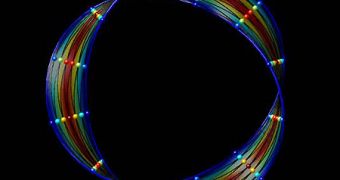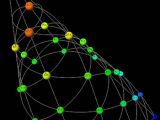Music might not have a physical shape, but it is possible to use a mathematical approach see what the shape of music might look like. Florida State University, Yale University and Princeton University researchers Clifton Callender, Ian Quinn and Dmitri Tymoczko respectively have recently demonstrated a technique through which music can be described through geometrical shapes by mapping it into space coordinates.
For example, music played with instruments with chords containing only two notes can be shaped into a M?bius strip, according to a research study published by Tymoczko nearly two years ago. Chords with three musical notes produce three dimensional conical shapes, where the major and minor chords are unique points on the object. Extending the theory even further to four-note chords would reveal a three dimensional pyramid.
"You can use these geometrical spaces to provide ways of visualizing musical pieces. These spaces give us a much better and comprehensive picture of the space of all possible chords", said Tymoczko. Quinn says that the discovery of the M?bius strip shape created by two-note chords came somehow as an amazing accomplishment amongst the researching team.
"But there was also a sense in which we weren't surprised, because any composer who has spent any time futzing around a piano invariably finds their fingers end up twisted in a knot. Knowing that there's a good mathematical reason for that is deeply satisfying", Quinn said. "Mathematics and music may be more linked together than any of us previously though", he continued.
"When music doesn't have words, it doesn't necessarily resemble anything in the real world. This is a feature people have been amazed by and found remarkable and a little bit terrifying. Traditionally, paintings always looked like things, poetry and literature were talking about things. But music is coming closer to pure truth. People who talk about mathematics say the same thing - it's not necessarily about anything, it's just truth", he said.
The technique can also show differences between several music styles, such as that between Paul McCartney and John Lennon. While McCartney's music forms a small number of motions in the geometrical spaces, Lennon makes use of a much wider set of options.
"One of the really exciting things about this research is that it allows us to see commonalities among a much wider range of musicians. In some sense, Bach and the Beatles are really exploiting the same geometrical features. In that sense they're not radically different. You certainly see larger trends. Over the 18th and 19th centuries people start exploring a wider variety of geometrical spaces. There's a general push towards increasing complexity and sophistication. They move from the three-dimensional cone to the four-dimensional space", says Tymoczko.
According to Tymoczko, one thing mathematics can't do is tell someone if the music they're making will be a big hit or not. In fact, understanding the shape of your music will do you no good. There is a good chance that you will eventually become a mediocre composer and making music just for its shape will only ensure that you get there a little faster.

 14 DAY TRIAL //
14 DAY TRIAL // 
